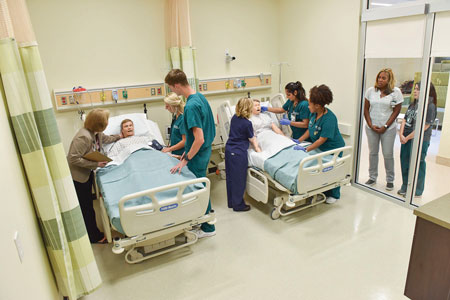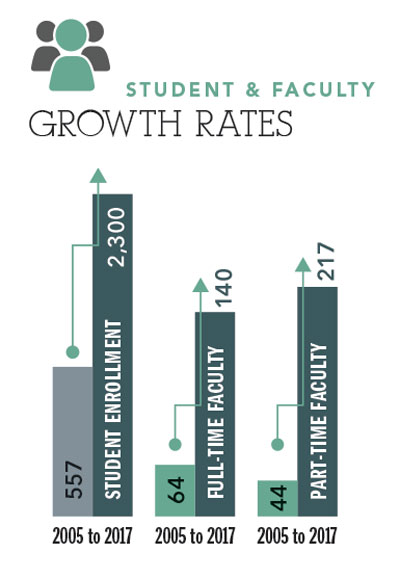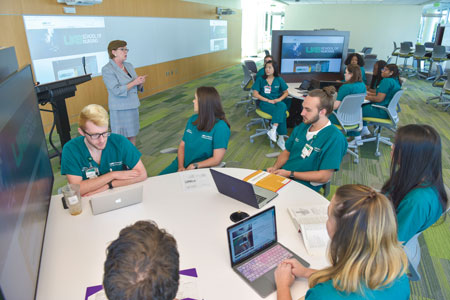
On September 6, the UAB School of Nursing ushered in a new era of innovation in nursing education, research and clinical practice, celebrating the grand opening of its expansion and renovation.
The completion of the 72,000-square-foot, $32 million project capped a number of strategic accomplishments of the past year that have been more than a decade in development, including U.S. News & World Report’s top 10 rankings for the Master’s and Doctor of Nursing Practice Programs and raising the NIH research funding ranking to 14th.
These achievements, said Dean and Fay B. Ireland Endowed Chair in Nursing Doreen C. Harper, PhD, RN, FAAN, serve as a launch pad to pursue new opportunities afforded by new technology, resources and room to grow.
“This is only the beginning,” Harper said. “The next step is continuing to improve where we are excelling and moving forward with new endeavors to stay on the leading edge.”
BUILDING ON A VISION
Long before plans were made for a larger building or a roadmap was created for achieving top rankings, the School, since its founding in 1950, has been focused on “building on a vision to sustain nursing leadership worldwide.”
When Harper came on as dean in 2005 it was with the goal of expanding that vision while increasing resources and revenues to propel the School forward in its impact on the world stage.
This trajectory of excellence started with a faculty-driven, five-year strategic plan focused on growing resources, the School’s role in the community, and building on identified strengths. What developed, as the School marked its 60th Anniversary was Vision 2010, which laid the foundation for the building campaign, and set the stage for a meteoric rise in national rankings, student numbers, research funding and practice impact. It also created flexibility for the plan to evolve over time so the School could respond to changes in the profession, health care and higher education.
INNOVATING EDUCATION
One key area identified for growth that has become a cornerstone of the School’s high-quality didactic and clinical education is technology.
Better online and classroom technology has enabled the School to develop innovative distance-accessible programs and pathways, including the RN to BSN and MSN Mobility Pathway, as well as expanding the reach and scope of the MSN, DNP and PhD Programs. This has resulted in exponential growth in student and faculty populations. From 2005 to 2017 student enrollment increased from 557 to 2,300, full-time faculty increased from 64 in 2005 to 140, and part-time faculty increased from 44 to 217.
“Our growth since 2005 also has brought in many top students and recruiting them for the next level of education has become a real strength of our School,” said Professor and Senior Associate Dean for Academic Affairs Linda Moneyham, PhD, RN, FAAN. “For example, we developed honors and dean’s scholars initiatives for high performing undergraduates that provide a pipeline for the next generation of nurse scientists for the BSN to PhD Pathway.”

New pathways have also been established, enabling the School to continue to grow the number of highly qualified nurses it produces, including partnerships with liberal arts schools that provide a pipeline into the Accelerated Masters in Nursing Pathway and with community colleges to provide a seamless transition from an associate’s degree to the BSN.
To expand to more seamless pathways in the future, technology is critical, Moneyham said.
“High-quality classroom and clinical experiences are vital to recruitment," Moneyham said. "What we have achieved with the building transformation ensures we will continue to develop world class nurse leaders, nursing faculty and nurse scientists of the future.”
Professor and Associate Dean of Technology and Innovation Jacqueline Moss, PhD, RN, FAAN, leads simulation and other educational technology efforts.
“When I joined the faculty in 2002, we had very limited simulation space. We have created a world-class program from the ground up and added more technology, space, staff and faculty to where we are today,” said Moss.
New faculty that have been added include Assistant Professor and Director of Clinical Simulation Penni Watts, PhD, RN, CHSE-A, and Assistant Professor and Nursing Simulation Coordinator Tracie White, DNP, CRNP, ACNP-BC, CNOR, CRNFA, among others, who oversee day-to-day operations of new and existing lab space. And completion of the building expansion has added five new state-of-the-art labs for nursing simulations, including a working operating room, as well as a nurse’s station and home health lab. Each comes with instructor-controlled manikins that simulate real-life scenarios. There also is a new eight-bed skills lab. The School now has more than 20,000 square feet of simulation and skills space.
Increasing expectations from technologically savvy students and faculty has also made classroom technology a priority, Moneyham said.
One classroom, the Innovation Collaboratory, is equipped with interactive workstations and device-sharing technology allowing students to share what they see on their screens with the class, or teams of clinicians and researchers can work together to translate the latest discoveries to the bedside. It also has streaming capabilities for sharing real-time video on campus and around the world.
“We are able to make what we are teaching a collaborative learning experience instead of the ‘sage on the stage’ where the faculty member is the only one who has knowledge,” Moss said. “Professional teams can also work together in the room or, in reality, anywhere there is the ability to connect, to collaborate on innovative health care solutions.”
Harper said the building expansion further moves the School to the leading edge of education and fulfills what was first laid out in Vision 2010.
“We are transforming the way students learn and faculty share knowledge,” she said. “We have created learning and collaboration spaces that promote the highest standards of teaching, motivating students and stimulating thinking, and are setting a new standard for preparing highly qualified nurse leaders at the undergraduate and graduate levels.”
PARTNERING FOR ACCESS TO HEALTH CARE
Expanding collaborations to impact nursing and health care through partnerships and other clinical endeavors also was a goal of Vision 2010. Recruiting the right leader, Associate Dean for Clinical and Global Partnerships Cynthia Selleck, PhD, RN, FAAN, was key to the success of this endeavor.
“When I came to the School in 2010, Dean Harper had established the Office of Clinical Partnerships, and I saw an opportunity to provide better health care access to the medically underserved in the area,” Selleck said. “We have since established numerous clinical partnerships to not only improve access to care but also develop the nursing workforce.”
Harper said Selleck and School leaders first looked across campus and then toward the community to expand its impact on high-quality health care for all Alabamians.
“If you have medicine, you always have nursing, so it made a lot of sense to align with our medical colleagues around the University,” she said.
Alignment with on-campus partners for clinical and educational endeavors included working with UAB Hospital Chief Nursing Officer Terri Poe, DNP, RN, NE-BC, and UAB Medicine CEO Will Ferniany, PhD, to establish the UAB Nursing Partnership; Chief Nursing Officer Deb Wesley, MSN, and Children's of Alabama to establish a clinical scholars initiative for nurses and a nurse practitioner residency program to improve child and adolescent mental health care; and the Birmingham VA Medical Center and its leaders, including Associate Director of Patient Care Services Cynthia Cleveland, DNP, RN, NE-BC, for the five-pronged VA Nursing Academic Partnership.
“The School also has clinical and research partnerships with the UAB Comprehensive Cancer Center, Palliative Care Center and other University-Wide Interdisciplinary Research Centers that provide clinical, education and research opportunities for our faculty and students,” Harper added.
The School also brought into the state more than $30 million in federal, foundation and other grants to deliver innovative nurse-managed health care to vulnerable populations in the community and to educate well-prepared nurse leaders sensitive to the needs of the underserved.
And the School continues to expand other nurse-managed interprofessional clinics and initiatives across Alabama to care for vulnerable populations and enhance learning opportunities for students, Selleck said.
“We are focused on transforming health outcomes in Alabama, especially in rural and underserved areas, and providing highly-qualified, advanced-practice prepared nurses to practice there,” Selleck said. “The building expansion and the technology it provides to reach even the most rural parts of Alabama is key to this mission."
The School also has built a foundation for international collaboration through its Pan American Health Organization/ World Health Organization Collaborating Center for International Nursing and has established partnerships with a number of international universities and centers.
“We continue to review the School’s PAHO/WHO work since its original designation in 1994 to build on our strengths,” said Associate Professor and PAHO/WHO Collaborating Center Deputy Director Ada Markaki, PhD, RN, PHCNS-BC. “And, we are looking at the latest global health trends to get a sense of where we stand and what we need to move forward. With the new technology available to us we have the opportunity to expand and really transform health globally, through innovations in education, clinical practice and research.”
GROWING THE RESEARCH ENTERPRISE
Vision 2010 and what has evolved set forth a multi-faceted plan to grow research and scholarship funding. That included recruiting key funded faculty, broadening funding sources and creating a foundation to support talented students and nurse scientists.
Key faculty recruitments, Harper said, included the late Karen Meneses, PhD, RN, FAAN, who came in 2007 to lead the School’s Office of Research and Scholarship as Associate Dean and Professor, laying the groundwork for the exponential increase in research funding over the next decade.
She was joined over the next several years by other key funded faculty, who brought in NIH portfolio funds, and other federal and foundation research and training funds.
“We’ve been able to recruit scientists who have generated research, funding and collaborations across nursing, medicine and other health professions with well-developed programs of research in cancer, heart failure, palliative care, HIV, aging, dementia and health services research in patient safety and quality,” Harper said. “We are fortunate to be aligned with UAB Medicine and the academic health science center and that also has helped to grow our research, especially around population health.”
These on-campus collaborations have been key in growing the School’s research portfolio beyond NIH dollars. In 2017, the School’s grant funding from sources including the NIH across all of its missions — teaching, research, and service, exceeded $11 million from the U.S. Department of Health and Human Services, Health Resources and Services Administration. Training funds and grants totaling more than $1.4 million from other organizations, including the Jonas Foundation, Robert Wood Johnson Foundation, Susan G. Komen and National Institute of Occupational Safety and Health provided support for graduate, doctoral and post-doctoral students.
“Our faculty have done a tremendous job leveraging competitive federal, foundation and intramural grants and those have helped build and support the infrastructure and scholarship of our faculty and students,” Harper said.
Mentoring also is a significant part of the School’s growth in research and scholarship. Access to the School's acclaimed faculty researchers in oncology, gerontology, palliative care, HIV/AIDS, nursing administration, Veterans’ care, among others, has been pivotal for students and early career faculty.

“With Dr. Meneses’ leadership and considerable effort among our faculty and staff, we have built an incredibly supportive team in our Office of Research and Scholarship to help mentor and develop our faculty through the application and submission process,” Harper said. “That, along with the incredible mentorship that our senior faculty, both in nursing and across the UAB campus, offer our younger scientists — as well as our students from the baccalaureate through the doctoral to the post-doctoral level — have helped fulfill the goals of Vision 2010 and beyond.”
Technology, Harper said, has become a common modality the School’s research teams are using to reach vulnerable populations, and the technology and resources available in the building expansion will help continue the growth the School has seen in research and scholarship.
“At this advanced level, research takes resources, and our expansion and renovation provide the resources we need to continue to play a leadership role in moving nursing and interdisciplinary research forward,” Harper said. “The technology also will enable us to translate and disseminate new knowledge back to the community quickly so that the quality of lives can be improved.”
FORGING THE FUTURE
For Harper, future plans remain consistent with the School’s history of leadership and excellence.
“There’s no question about what we’re going to do moving forward — how are we going to improve health care for everyone in the state? How do we use these tremendous resources to move ahead?" Harper said. “We will continue to expand educational opportunities and increase access to care and research contributions to positively impact the health of our community and the world — and we will think outside the box, filling the gaps and niches in the health system.
“This building gives us a center for innovation and collaboration to do things that have never been done before,” Harper added. “We will continue innovation through technology and use faculty expertise to reach beyond our boundaries to provide the workforce that meets the needs of Alabama and beyond.”